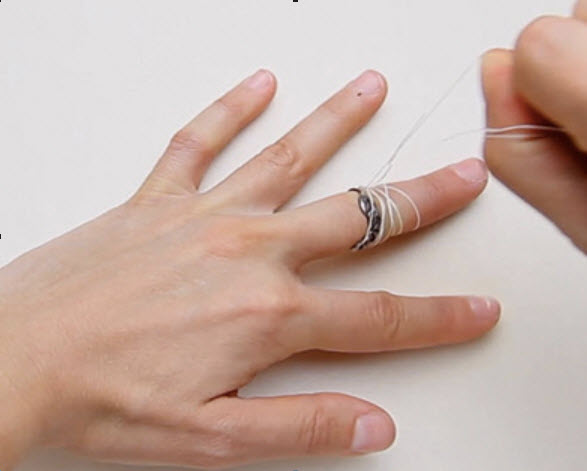Fun With Floss!
This super strong material is even handier than you thought.
Now I know what you are thinking. What the heck would I use floss for other than flossing my teeth. After all, Drs. Rothchild and Raegan both extol the value of flossing my teeth to prevent decay and gum disease. Why would I use it for anything else? I counter with “you are right”. But sometimes it’s just fun, and you can amaze your friends and family at the same time!
Dental floss is considered a key element in proper oral hygiene. However, according to the ADA, only about 12 percent of Americans floss daily. The concept of flossing isn’t a new idea at all and it’s surprising that patients don’t take it more seriously. In fact, discoveries made by researchers have suggested that cleaning between the teeth was practiced as early as the Prehistoric period.
Although the earliest versions of floss were similar to what is found in stores today, there have been quite a few advancements in the design to help simplify the process and create a more comfortable experience.
Prehistory: The exact date of the first use of dental floss is unknown but researchers found evidence that floss existed in prehistoric times. Grooves from floss and toothpicks have been found in the mouths of prehistoric humans. It is suggested that horse hair was used as floss and twigs were used as toothpicks to dislodge anything from the teeth.
1815: American dentist Dr. Levi Spear Parmaly introduces the idea of using waxed silken thread as floss. Later in his career, he published a book, A Practical Guide to the Management of Teeth, which emphasized the importance of brushing and flossing daily.
1882: Unwaxed silk floss is mass-produced by the Codman and Shureleft Company.
1898: The first dental floss patent is granted to Johnson and Johnson.
1940s: Due to rising costs of silk during World War II and its tendency to shred, nylon replaces silk as the main material in floss. This development is credited to Dr. Charles Bass, who is also known for making floss an essential part of daily oral hygiene.
1980s: The first interdental brush is invented as an alternative to flossing.
Today: Today we are seeing the use of Gore-Tex in some varieties, and the addition of spongy floss and soft floss for sensitive gums. Floss picks have also become quite popular and simplify the process of flossing posterior teeth and flossing around braces.
Some great ideas you may not have heard…
Hang Frames:
A quality dental floss is sturdy enough to hold lightweight frames, yet it won’t scratch walls like a wire can. You can also double or triple up the strands to make extra strength.
Cut Soft Food Very Cleanly:
Use unflavored floss for this one or you may introduce a mint flavor to your selected food. You can easily slice through cake, cheese or a roll of cookie dough without smooshing the surface. Wrap each end around your fingers and keep it taught. Press down through the item. Yum!
Remove Cookies From a Tray:
When you don’t want to wait for you cookies to cool, but you’re afraid your still-hot cookies might crumble, you can use the floss trick to separate them from the baking sheets, and then gently slide them onto a serving plate.

Remove a Ring:
Avoid frustration and pain trying to yank your too tight ring off your finger. Slip an 8″ length of floss under the ring and snugly wind it around the lower part of your finger (including the knuckle) to temporarily bind it. Quickly slide the ring off your finger, then unwind the floss.
Rescue Photos:
To separate stuck on photos from the pages of an old album or the glass of a frame, gently move a length of floss in a sawing motion between the two.
Separate Stuck Together Postage Stamps:
See rescue photos
Clothes Line Drying:
If you ever need to make a quick clothesline, super-strong floss is a great choice. Just suspend the two stationary objects (like a shower head, hook, door knob or curtain rod) and hang your clothes to dry. Tough enough to hold even wet clothes.
Fishing Line:
Use floss like a fishing line with your fishing rod. Don’t have a rod? Use a dangling earring as hook, or a safety pin to fish. Use the dental floss box to store bait, such as earthworms, you may find.
String Popcorn:
Dental floss provides a great sturdy medium for stringing popcorn, cranberries, or whatever! Great for making Cheerios necklaces with kids too!
Starting a Fire:
Waxed floss burns! Wrap waxed floss around a dry stick bark or a bundle of kindling, then light it like a candle.
Luggage Tie:
You can seal up your luggage, or other personal possessions, by wrapping the zippers tightly with floss. This works in lieu of a zip-tie.
Kitchen Twine:
Some food products like meat and bacon need to be bound when cooked. In the absence of string, unwaxed and unflavored dental floss comes in handy. Tie the food to be cooked with the dental tool and the results will be practically the same. Rest assured, it won’t burn or melt!
Quiet a Dripping Faucet:
If you find yourself in a hotel room unable to sleep because the tap in the bathroom is dripping loudly, tie a piece of floss to the bottom of the faucet and guide the string down into the drain. Rather than dripping, the water will then slide right along the string and down the drain, noiselessly.
Sealant Tape:
Use dental floss instead of Teflon tape, to block leaky gaps around parts that screw into place. Wind a length around the fitting’s threads half a dozen times before screwing it on.
Prevent Rope From Fraying:
This is an old Boy Scout’s trick: to “whip” a rope, or prevent it from fraying, tightly loop the floss around the rope.



